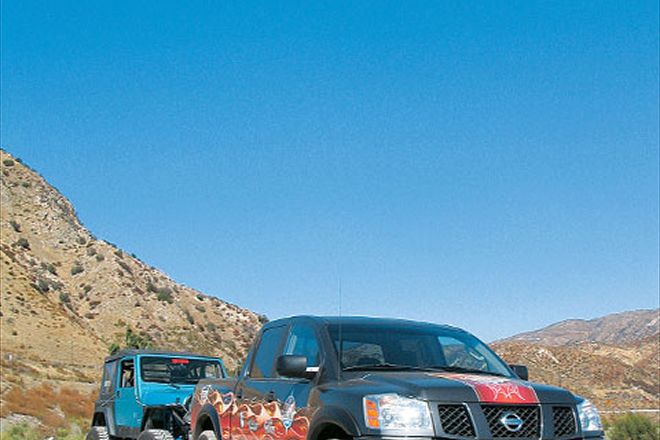
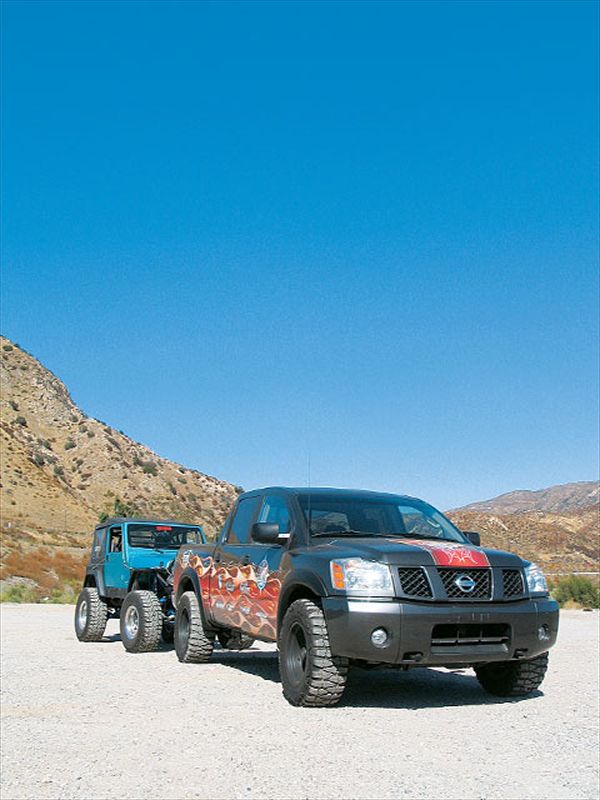 Back from a brief appearance at the 2005 TTC, she's armed with Bushwacker fender flares, 33-inch Nitto Mud Grapplers, a set of 18-inch Teflon-coated American Racing Mojave wheels, and a stunning graphic treatment from the creative minds at Ape Wraps.
Back from a brief appearance at the 2005 TTC, she's armed with Bushwacker fender flares, 33-inch Nitto Mud Grapplers, a set of 18-inch Teflon-coated American Racing Mojave wheels, and a stunning graphic treatment from the creative minds at Ape Wraps.
If you've followed the buildup of our Top Truck Challenge-inspired Mega Titan, you already know how far we at Four Wheeler are willing to go to make Nissan's fullsize work well off pavement. And though our Mega Titan has received a great deal of praise from critics and readers alike, we've also found that some people have absolutely no interest in modifying a late-model pickup to that extent. Nor do all readers subscribe to the TTC style of four-wheeling. In fact, it's almost impossible for the majority of our readership to justify taking a perfectly good-not to mention expensive-pickup truck and changing it so heavily that it can't be driven legally on public roads. This is what sets our two Titan projects apart. We showed you our wild side with the first truck. Now, with the Everyday Titan, we're going for real-world appeal.
To help differentiate between our Titan twosomes, we want to identify the activities we plan to use our second Titan for.
Just as the name implies, the Everyday Titan will serve as a daily driver, a tow rig, a fun hauler, and a weekend trail rig. As such, we plan to highlight products that increase comfort, safety, performance, and utility. When all is said and done, we want this Titan to comfortably navigate thick L.A. traffic all week long, and then come Friday afternoon, hitch up an ATV trailer or toy hauler with all the necessities for a weekend away from it all. After all, that's why most Americans buy pickups, isn't it?
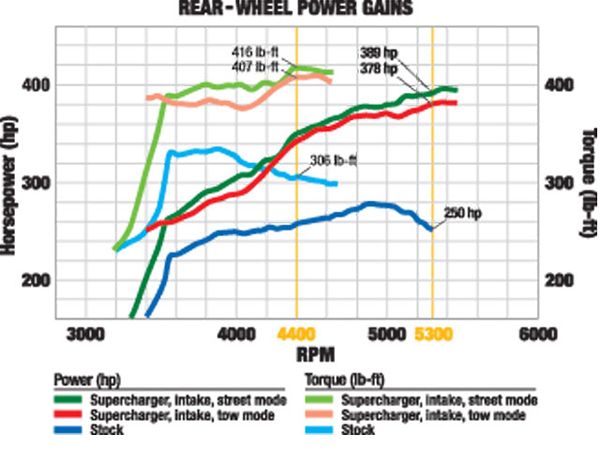 Here is our Everyday Titan's dyno data. We were surprised to learn we gained 118 hp and 82 lb-ft of torque in street mode.
Here is our Everyday Titan's dyno data. We were surprised to learn we gained 118 hp and 82 lb-ft of torque in street mode.
In this segment, we're going to address the Everyday Titan's need for additional horses under the hood. Now don't get us wrong-the Titan's stock 5.6L V-8 does a terrific job smoking the P265/70R18 tires. It's just when you add 60-plus pounds of steel and rubber at each corner and ask for the same performance, it's not going to happen. So we took a few steps to see how much we could increase our truck's performance. First, we started with a cold-air intake from NISMO. Next, we salvaged the Banks Monster after-cat exhaust system we removed from our Mega Titan (see Nov. '05) shortly before the SEMA show last year. Finally, we went to Stillen of Costa Mesa, California, for a brand-new supercharger. Stillen spent 13 months developing its Supercharger kit for the Titan, Armada, and Infiniti QX56. The system was engineered for daily drivers who want a reliable increase in performance for towing and street applications. The kit uses an Eaton positive-displacement twin-rotor compressor to develop 6 psi of manifold pressure. We were very impressed with this kit's completeness. It's also worth mentioning the system's CARB-approval certification.
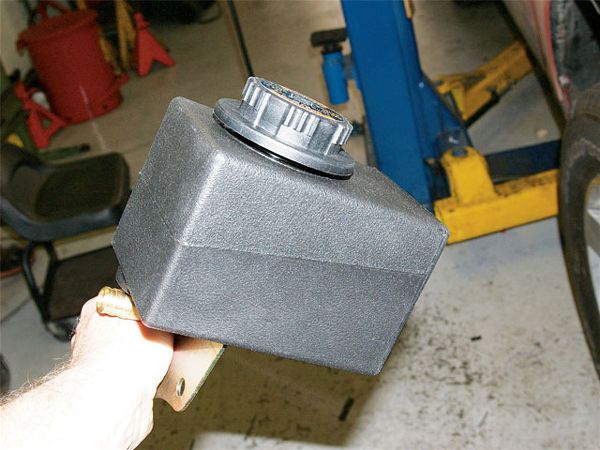 This is the Stillen intercooler reservoir tank. This poly tank is plumbed into the closed-loop intercooler system adn housesa small volume of reserve coolant to allow for expansion and contraction at varied altitude and temperatures. It mounts right nest to the stock power-steering reservoir via a clean laster-cut zinc-coated bracket.
This is the Stillen intercooler reservoir tank. This poly tank is plumbed into the closed-loop intercooler system adn housesa small volume of reserve coolant to allow for expansion and contraction at varied altitude and temperatures. It mounts right nest to the stock power-steering reservoir via a clean laster-cut zinc-coated bracket.
In a word, amazing! The seat-of-the-pants difference is unbelievable. This truck will light the stock rear tires a whole city block before hooking up. With the added weight of the 33-inch Nittos on 18-inch wheels, the truck still performs much better than stock. However, we're unsure how long the rest of the drivetrain will last with this much power on tap. The transmission is now our primary area of concern as the factory torque converter is no match for this kind of consistent torque. On the dragstrip, our Titan laid down an impressive 13.8-second quarter-mile time. And around town, the Everyday Titan is quicker than any big-block vehicle we've challenged. The sound produced by the supercharger coupled to the Nismo intake is downright scary. The Banks Monster exhaust sounded even more grown-up after the truck was supercharged. Long grades make us think we have a jet engine under the hood. The whine of the Eaton unit, in combination with the NISMO intake, is quite loud. Stillen says without the NISMO intake the supercharger upgrade is almost unnoticeable in terms of noise.
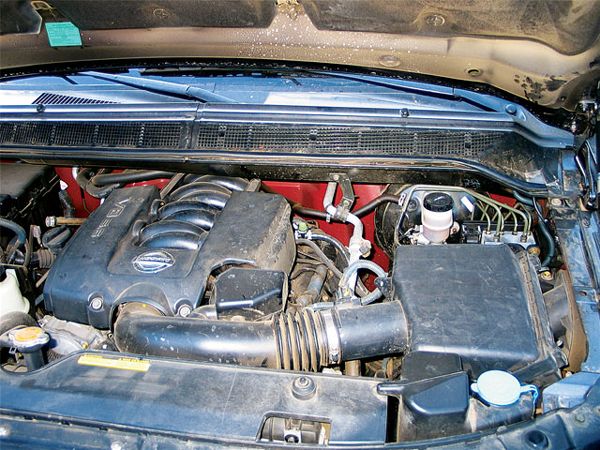
The only drawback to the Stillen supercharger is that it, like most superchargers, requires high-octane premium gas. Here in L.A., this added expense can run between $16 and $26 per fill-up. As for the supercharger's affect on everyday driving, we did notice a slight increase in fuel economy during light-footed highway driving scenarios, but these were short-lived as we couldn't help but stab the go-pedal on even the slightest of grades. We even used our Everyday Titan once to haul our project Teal-J to Las Vegas for the SEMA show. Needless to say, towing is now one of our truck's newest strengths. We only hope the Dana 44 rear axle will survive until we build it up.


 PhotosView Slideshow
PhotosView Slideshow








